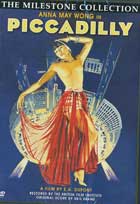
Piccadilly 1929, 2005
Distributed by Milestone Films & Video, PO Box 128, Harrington Park, NJ 07640-0128; 800-603-1104
Produced by E.A. Dupont
Directed by E.A. Dupont
DVD, b&, color tinted, 109 min.
Sr. High - Adult
Film Studies, Asian American Studies
Date Entered: 04/14/2005
Reviewed by Mike Boedicker, Danville Public Library, IllinoisDVDs are a boon for film study because they offer extra content that, at its best, deepens our understanding of the film. The 2003 documentary Capturing the Friedmans worked better as a DVD than as a theatrical release because the DVD bonus features were not mere filler but carefully selected material that added significantly to the story. Image Entertainment and Milestone’s handsome DVD presentation of E.A. Dupont’s silent 1929 British film Piccadilly falls into this category, using bonus features to explore race and identity issues while also highlighting differences between silent cinema and talkies during a key transitional period in film history.
The story itself is an unexceptional melodrama about nightclub owner Valentine Wilmot (Jameson Thomas), who is torn between his allegiance to Mabel (Gilda Gray), a fading dancer at the club, and his obsession with Shosho, a new Asian dancer who quickly overtakes Mabel as the star attraction. Shosho is played brilliantly by the Chinese-American actress Anna May Wong, who until recently was largely forgotten but is now being rediscovered some forty years after her death. Though given third billing in the film’s credits, Wong is clearly the star, and the DVD packaging reflects this: her name and image are featured alone on the cover art, and she is pictured ten more times in the accompanying booklet, while contemporaneous “stars” Thomas and Gray are pictured only once. DVD bonus features about Wong include a photo gallery and excerpts from a panel discussion, “Dangerous to Know: The Career and Legacy of Anna May Wong,” presented at the 2004 San Francisco International Asian American Film Festival. (This panel discussion suffers from poor sound, the only deficiency in the otherwise solid extras).
The disc’s many accolades to Wong are well deserved. Like Garbo, Wong can say more with a sly grin than with pages of dialogue, and she captures at once both the innocence and the shrewdness of Shosho. But director Dupont warrants praise too. Silent films are often criticized for hammy acting, but the performances in Piccadilly - and not just Wong’s - are notable for their subtlety. The film is also visually inventive, recalling the best of German Expressionism in its use of lighting, moving camera, and optical effects. Piccadilly is, foremost, a moving picture, and not merely the filmed play it might have become if shot as a talkie.
Which brings us to another bonus feature that expands our appreciation of the film. Piccadilly was released in early 1929 as a silent film with musical score, but was re-released later that year with a tedious 5-minute synch-sound prologue in which Wilmot, now the owner of a modest tavern, tells a patron about his previous career as nightclub owner. The film proper then begins as a flashback. Undoubtedly added at the time to cash in on the sound craze, the prologue today only demonstrates the vast differences between its dull, expository technique and the visual richness of the original silent film. Critics who write about this transitional era often argue that the art of cinematic storytelling was abandoned before it could peak. The studios’ intoxication with sound, coupled with early technical limitations (noisy cameras were placed in soundproof “iceboxes” which greatly limited their mobility) produced in the early 1930’s a “style” of cinema more akin to filmed theater in its reliance on exposition and static shots. Pictures became a slave to sound, critics have lamented, but if sound had been delayed another ten or twenty years then film grammar would have reached new levels of complexity. It’s a compelling argument given credence by this bonus feature.
Featuring a nicely restored print by the British Film Institute and loaded with carefully selected bonus materials that increase our appreciation of the film, Piccadilly is recommended for film study and silent cinema collections in academic and public libraries.